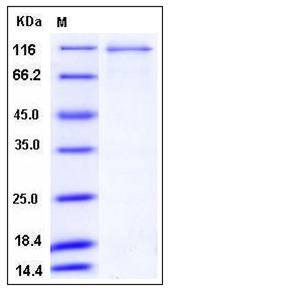Human MAP4K2 / GC Kinase Protein (His & GST Tag)
BL44,GCK,MAP4K2,RAB8IP
- 100ug (NPP4070) Please inquiry
| Catalog Number | P11826-H20B |
|---|---|
| Organism Species | Human |
| Host | Baculovirus-Insect Cells |
| Synonyms | BL44,GCK,MAP4K2,RAB8IP |
| Molecular Weight | The recombinant human MAP4K2/GST chimera consists of 1049 amino acids and has a calculated molecular mass of 119 kDa. It migrates as an approximately 116 kDa band in SDS-PAGE under reducing conditions. |
| predicted N | Met |
| SDS-PAGE |  |
| Purity | > 87 % as determined by SDS-PAGE |
| Protein Construction | A DNA sequence encoding the human MAP4K2 (AAH47865.1) (Met 1-Tyr 812) was fused with the N-terminal polyhistidine-tagged GST tag at the N-terminus. |
| Bio-activity | Kinase activity untested |
| Research Area | Cancer |Signal transduction |Signaling Pathway |Representative pathway |MAPK singaling Pathway |
| Formulation | Supplied as sterile 50mM Tris, 100mM NaCl, pH 8.0 1. Normally 5 % - 8 % trehalose and mannitol are added as protectants before lyophilization. Specific concentrations are included in the hardcopy of COA. |
| Background | Mitogen-activated protein kinase kinase kinase kinase 2, also known as B lymphocyte serine/threonine-protein kinase, Germinal center kinase, MAPK/ERK kinase kinase kinase 2, MEK kinase kinase 2, Rab8-interacting protein and MAP4K2, is a cytoplasm and peripheral membrane protein which belongs to the protein kinase superfamily, STE Ser/Thr protein kinase family and STE20 subfamily. MAP4K2 contains one CNH domain and one protein kinase domain. Although this kinase is found in many tissues, its expression in lymphoid follicles is restricted to the cells of germinal centre, where it may participate in B-cell differentiation. MAP4K2 can be activated by TNF-alpha, and has been shown to specifically activate MAP kinases. It is also found to interact with TNF receptor-associated factor 2 (TRAF2), which is involved in the activation of MAP3K1 / MEKK1. MAP4K2 enhances MAP3K1 oligomerization, which may relieve amino-terminal mediated MAP3K1 autoinhibition and lead to activation following autophosphorylation. It may also play a role in the regulation of vesicle targeting or fusion. |
| Reference |
